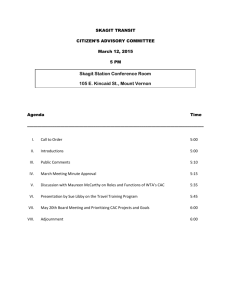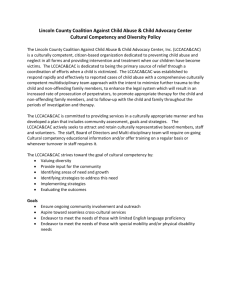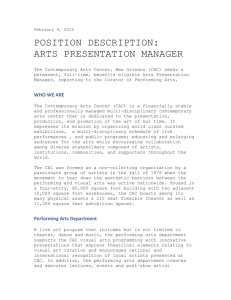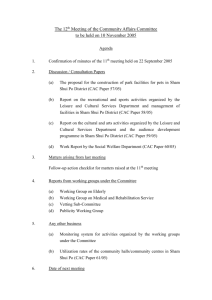Investment-Guidelines-First-Draft-Sep-08-2015
advertisement
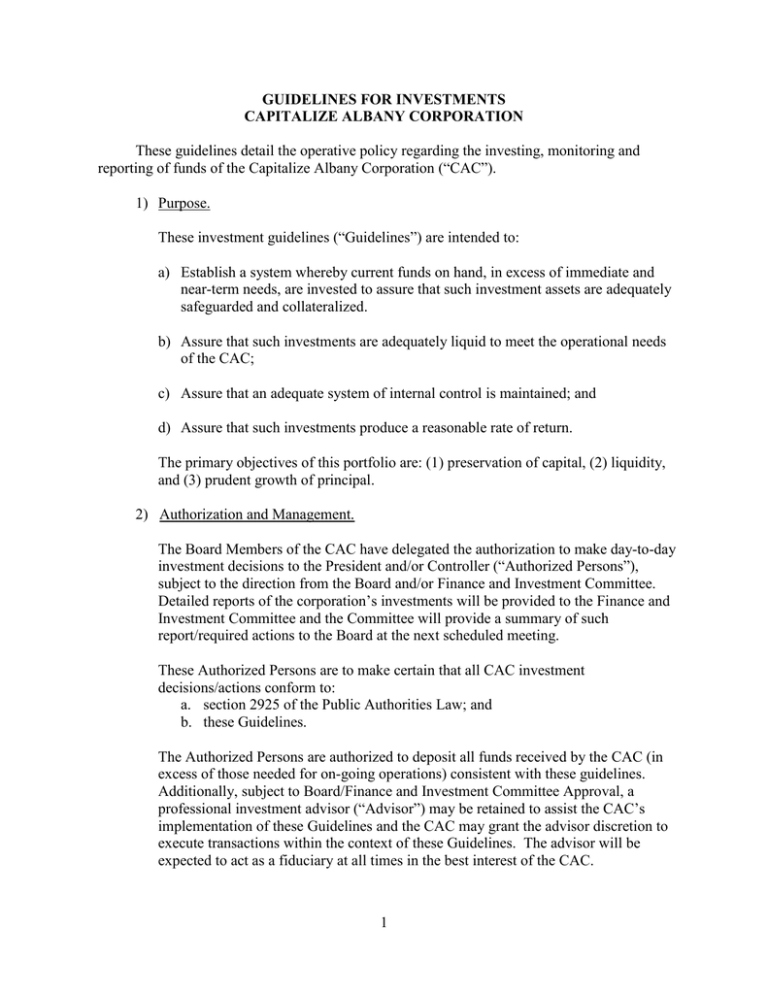
GUIDELINES FOR INVESTMENTS CAPITALIZE ALBANY CORPORATION These guidelines detail the operative policy regarding the investing, monitoring and reporting of funds of the Capitalize Albany Corporation (“CAC”). 1) Purpose. These investment guidelines (“Guidelines”) are intended to: a) Establish a system whereby current funds on hand, in excess of immediate and near-term needs, are invested to assure that such investment assets are adequately safeguarded and collateralized. b) Assure that such investments are adequately liquid to meet the operational needs of the CAC; c) Assure that an adequate system of internal control is maintained; and d) Assure that such investments produce a reasonable rate of return. The primary objectives of this portfolio are: (1) preservation of capital, (2) liquidity, and (3) prudent growth of principal. 2) Authorization and Management. The Board Members of the CAC have delegated the authorization to make day-to-day investment decisions to the President and/or Controller (“Authorized Persons”), subject to the direction from the Board and/or Finance and Investment Committee. Detailed reports of the corporation’s investments will be provided to the Finance and Investment Committee and the Committee will provide a summary of such report/required actions to the Board at the next scheduled meeting. These Authorized Persons are to make certain that all CAC investment decisions/actions conform to: a. section 2925 of the Public Authorities Law; and b. these Guidelines. The Authorized Persons are authorized to deposit all funds received by the CAC (in excess of those needed for on-going operations) consistent with these guidelines. Additionally, subject to Board/Finance and Investment Committee Approval, a professional investment advisor (“Advisor”) may be retained to assist the CAC’s implementation of these Guidelines and the CAC may grant the advisor discretion to execute transactions within the context of these Guidelines. The advisor will be expected to act as a fiduciary at all times in the best interest of the CAC. 1 3) Investment Strategy CAC’s investment objectives will be achieved primarily with fixed-income investments and, to a lesser extent, with quality equity investments. However, there is no requirement that the portfolio contain equities. Fixed-income securities in the combined portfolios will include cash equivalents, short- and intermediate-term fixed-income securities. The portfolio will be allocated to these categories based upon cash flow needs as determined by CAC. Equity investments will be well diversified, high grade and readily marketable. The investment return on the short-term fixed-income portion of the portfolio will be measured against short-term U.S. Treasury Bills. The investment return on the intermediate-term fixed–income portion of the portfolio will be measured against the Barclays Intermediate Government Credit Index. The investment return on the equity portion of the portfolio, when appropriate, will be measured against the S&P 500. Asset Allocation Asset Class Equities Domestic International* Fixed Income Cash or Equivalents Min. Wt. 0% 85% 0% 80% 5% Max. Wt. 15% 100% 15% 95% 20% Representative Index S&P 500 and MSCI EAFE S&P 500 MSCI EAFE BCS Int. Govt./Credit** Treasury Bill * Only broadly diversified Exchange Traded Funds will be used for investing in international equities. ** Or other broad-based bond market benchmark agreed upon by CAC. 4) Types of Investments. a. Cash and Fixed-Income. Subject to the conditions and restrictions contained in 3(A)(8) below, the following types of cash or fixed income investments are approved: 1. Deposits in Savings, Checking and/or Money Market Type accounts of banks doing business in New York that are collateralized or fully insured by the FDIC as to principal and expected interest. 2. Obligation of the U.S. Treasury, AAA-rated U.S. Government Agencies and obligations guaranteed by the U.S. Treasury or AAA-rated U.S. Government agencies. There is no limit on these investments, except that no more than 15% of the fixed-income segment can be invested in Government guaranteed mortgage pass through securities. 3. Certificates of Deposit collateralized or fully insured by the Federal Deposit Insurance Corporation as to principal and expected interest. 2 4. Corporate debt obligations as follows: a. Commercial Paper; and b. Short-Term Notes or Corporate Bonds Commercial paper must be rated at least A1/P1 with a maximum maturity of nine months. Corporate notes and bonds must be rated at least A1 by Moody’s or A+ by Standard and Poor’s. 5. Money market funds managed by nationally recognized investment management companies in funds with net assets of $1 billion or more. 6. Tax-Exempt or Taxable Municipal Securities as follows: a. Municipal notes and bonds; b. Adjustable rate municipals; and c. Tax-Exempt commercial paper. Municipal obligations must be rated at least “A” (or the equivalent) by a nationally recognized credit rating agency. Insured obligations must have an underlying rating of at least “A”. 7. Any obligation that is not guaranteed by the U.S. Government or one of its agencies is limited to 10% of the portfolio. 8. The Following Conditions and Restrictions Apply to Fixed-Income Investments: a. No less than 25% of the portfolio will possess a final maturity of one year or less. b. The maximum weighted average maturity of the fixed-income securities (exclusive of the portion of the portfolio that matures within one year) may not exceed four years. c. No less than 50% of the fixed-income securities must be obligations of the U.S. Treasury or Government Agency. d. Fixed income securities with a maturity, expected average maturity, or reset period greater than 10 years are prohibited. e. Fixed income or interest rate futures are prohibited f. Risky or volatile derivative securities as commonly defined by the financial industry are prohibited. g. Zero coupon Treasury bonds are permitted. h. CMO securities of any type are not permitted. i. Cash reserves should be invested in interest bearing securities or in an appropriate money market fund or saving/checking account. 3 Since it is not a regular business practice for a written contract with respect to these types of investments, no written contract is required. The operating practices herein shall govern. b. Equity. Equity investments are to be chosen from the New York Stock Exchange, American Stock Exchange, the regional exchanges, or the national over-thecounter market. No more than 30% of the market value of the equity portion of the portfolio should be in any one industry and no more than 10% in any one security. c. Collateral and Securitization. Other than those investments identified in 4(a)(1) and 4(a)(3), no collateralization or securitization of the investments are required. d. Written Contracts. No written contracts are required for any of the approved CAC investments except for all normal and customary investment/account documents (e.g. account statements, etc.) which provide that CAC is the full and only owner of the respective investment. 4) Operating Procedures. a) Approvals: The Advisor will be consulted by the Authorized Persons prior to executing any investment transactions. Authorized Persons must approve all investment transactions before they are executed. b) Collateral: The custodian of all collateral involved in any investment transaction must be either the CAC or third party custodian acceptable to the CAC. If at any time the required collateral does not equal the value of the investment, the CAC shall inform the third party custodian of additional collateral required. If additional collateral is not added immediately by the third party custodian involved, the CAC shall demand the return of the amount invested. Any custodian or trustee of securities in any transaction of which the CAC is a principal may not relinquish control over such securities without written consent of the CAC and the bank. Whenever investments require collateralization, such investments must be collateralized by direct obligations of the United States or New York State Government or obligations the principal and interest of which are guaranteed by the United States, one of its agencies or New York State Government. c) Tracking and Accounting. CAC will account for investments in accordance with generally accepted accounting principles (GAAP) for all financial statements. CAC shall receive reports monthly from any custodian/bank holding CAC investments. The Controller will review such reports monthly and verify the principal amount and market values of all investments and collateral. 5) Guidelines Annual Review or Modifications. 4 a) The CAC Finance and Investment Committee and Board will review these Guidelines at least annually and may by Board resolution modify these Guidelines at any time. 6) Reports and Audits. a) Quarterly reports of investment activity and portfolio reporting will be provided to the CAC’s Finance & Investment Committee and a summary of each such quarterly report will be provided by the Committee to the Board. At least annually, and additionally as determined by the CAC Finance & Investment Committee, a report on the investment portfolio and activity will be provided to the Board. The portfolio reporting will include an estimate of fair value (market value) as obtained from the Bloomberg, financial correspondents or nationally published sources. Also included will be the characteristics of each investment, the net change in fair value since the prior month-end, with summary information for the entire portfolio. b) Any retained investment advisor will meet with the CAC Board at least annually to discuss the portfolio and any questions of the CAC Board. c) Annual Investment Audit. Each year, the CAC shall cause its independent auditors to conduct an audit (the “Annual Investment Audit”) regarding the CAC’s investments. The Annual Investment Audit shall determine whether CAC has complied with: 1. its own investment policies; adequate accounts and records are maintained which accurately reflect all transactions and report on the disposition of the CAC’s assets; and a system of adequate internal controls is maintained; and 2. applicable laws and regulations. d) Annual Investment Report. The CAC Controller shall prepare and submit an annual investment report to the Board within 90 days after the close of each fiscal year of the CAC. Upon Board approval, the report shall be filed with the City of Albany and entered/certified into the Public Authority Reporting Information System (“PARIS”). Such report shall include the following: 1. The Guidelines required by Section 2925(3); 2. The results of the Annual Investment Audit described above; 3. The investment income results of the CAC; and 4. A list of the total fees, commissions or other charges paid for CAC investment associated services by the CAC since the date of the last investment report. The Annual Investment Report shall be filed within ninety (90) days after the close of the CAC’s fiscal year. 7) Criteria for Selection of Investment Banks or Firms and Brokers. 5 The following are criteria for the selection of Investment Banks or Firms and Brokers: a) Investment Banks or Firms and Brokers authorized to do business within New York State. b) Investment Banks or Firms and Brokers in business for over (5) five years. c) Investment Banks or Firms and Brokers that have demonstrated a proven record of returns, that meet or exceed the yield and total return generated from Treasury benchmarks. e) Investment Managers/Advisors must be registered with the Securities and Exchange Commission (SEC) while Investment Brokers/Dealers must be members in good standing with the Securities Investors Protection Corporation (SIPC) and the Financial Industry Regulatory Authority (FINRA). 6
